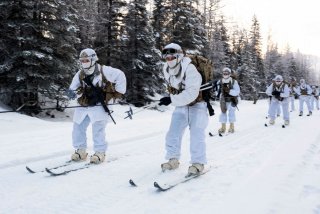Army Sees New Tactical Vehicle as Critical to Its Arctic Warfighting
The Army plans to possibly acquire as many as 200 Cold Weather All Terrain Vehicles through an upcoming deal in 2022, an Oshkosh Defense statement says.
Here's What You Need to Remember: A recently unveiled Army Arctic Strategy paper, called “Regaining Arctic Dominance,” specifically cites “mobility” as a serious and growing challenge to Army operations in the Arctic, certainly a circumstance which might explain why the service is moving quickly to acquire these vehicles.
The Army is building a first-of-its-kind tactical vehicle to conduct high risk combat missions in extreme cold weather conditions in the Arctic as part of an effort to increase its force presence and operational tempo in the region.
The service awarded a new prototyping deal to an Oshkosh Defense-ST Engineering industry team to build its first Cold Weather All Terrain Vehicle (CATV). The CATV, based in large measure upon the ST Engineering Bronco 3 family of vehicles, will perform Arctic Command and Control, Casualty Evacuation or troop transport missions amid the frozen, dangerous and uneven Arctic landscape.
A recently unveiled Army Arctic Strategy paper, called “Regaining Arctic Dominance,” specifically cites “mobility” as a serious and growing challenge to Army operations in the Arctic, certainly a circumstance which might explain why the service is moving quickly to acquire these vehicles.
“The Arctic, however, is not challenging solely due to extreme cold temperatures. In many instances, mobility is actually at its highest state in the winter. Summer poses significant challenges for many wheeled vehicles, while the most challenging period is the spring thaw when ground movement becomes impossible across considerable swaths of territory,” the strategy writes.
Part of the Army aim articulated in the strategy is to, at least in part, address this mobility challenge by replacing its existing Small Unit Support Vehicles with a new extreme cold weather, high-altitude platform.
“The ice cover in the Arctic Ocean fell by 11.5% each decade between 1979 and 2012. The rate of decline reached 13.3% by 2017, suggesting the rate of decline in the ice pack is gaining pace rather than holding constant. The warming of the Arctic has led to longer windows of reduced ice conditions over a larger range of area,” the strategy states.
Oshkosh has built Mine Resistant Ambush Protected (MRAP) vehicles and now is putting that technology towards the Artic. The Army already uses the MRAP All Terrain Vehicle (M-ATV) as well as the Joint Light Tactical Vehicle. Given that these kinds of vehicles are already in service, it would not be surprising if some of the new CATV features were built upon or modeled after some of the successful elements of the M-ATV. Certainly driving off road in a high-threat improvised explosive device (IED) environment requires elements of engineering expertise of potential relevance to the Arctic.
The M-ATV came into existence in 2008 and 2009 when, following the IED-thwarting success of Mine Resistant Ambush Protected Vehicles in places like Afghanistan, Operational Commanders in theater released an urgent request for a more maneuverable, off-road vehicle which could both operate at high speeds and also provide MRAP-like blast protection from roadside bombs. While roadside bombs may not necessarily present a huge threat in places like the Arctic, the M-ATV does incorporate a first-of-its-kind TAC 4i independent suspension system designed to optimize off road performance. Therefore, while there may not be a need for a blast-deflecting V-shaped hull, there is quite certain to be rugged, uneven terrain in the Arctic which will require M-ATV-like suspension.
The Army plans to possibly acquire as many as 200 CATVs through an upcoming deal in 2022, an Oshkosh Defense statement says.
Kris Osborn is the defense editor for the National Interest. Osborn previously served at the Pentagon as a Highly Qualified Expert with the Office of the Assistant Secretary of the Army—Acquisition, Logistics & Technology. Osborn has also worked as an anchor and on-air military specialist at national TV networks. He has appeared as a guest military expert on Fox News, MSNBC, The Military Channel, and The History Channel. He also has a Master’s Degree in Comparative Literature from Columbia University. This article first appeared earlier this year.
Image: Reuters.

